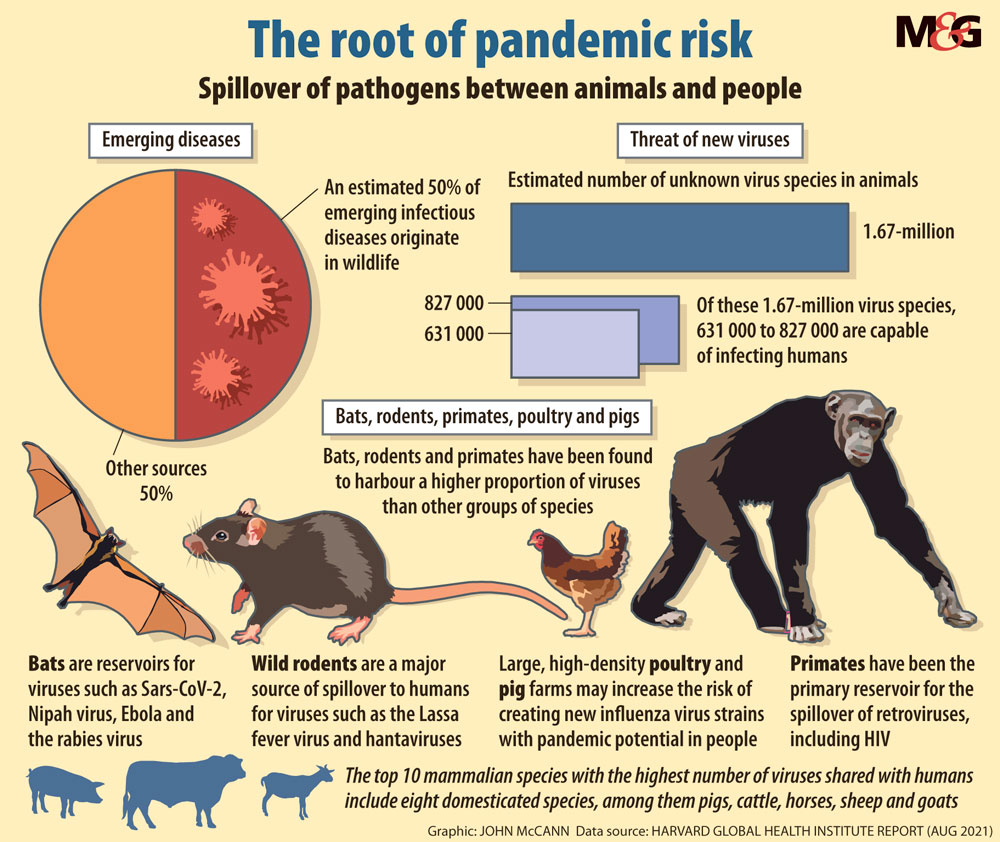No one wants to endure another pandemic like Covid-19, yet the likelihood of one occurring “may be greater than ever”, to quote scientists at Harvard University.
How to prevent the next pandemic was the key question addressed by the scientific task force for preventing pandemics, convened in May by the Harvard Global Health Institute and the Center for Climate, Health, and the Global Environment at Harvard TH Chan School of Public Health.
In its new report, the task force found that the spillover of possible pandemic pathogens — when a virus hops from one species to another — occurs due to several factors. These include livestock operations; wildlife hunting and trade; land-use change, particularly the destruction of tropical forests; the expansion of agricultural lands, especially near human settlements; and rapid, unplanned urbanisation.
Climate change, too, is shrinking habitats and pushing animals on land and sea to move to new places, creating opportunities for pathogens to enter new hosts.
By 2070, mammal species responding to changes in climate and land use are predicted to aggregate at high elevations, in biodiversity hotspots, and in areas of high human population density in Asia and Africa, resulting in the sharing of novel viruses between 3 000 and 13 000 times, according to the report.
Although vaccines, drugs, tests and the strengthening of healthcare systems are critical to contain disease outbreaks once they occur, they do not fully address the spillover of pathogens between animals and people or the pandemic risk this causes.

“Even with the unprecedented short interval between disease emergence and vaccine availability and availability of testing, the disease [Covid-19] continues to spread, aided by the evolution of variants that are more contagious, political divisions and the spread of misinformation,” the report says.
Furthermore, the task team says, the reliance on post-spillover interventions must be considered in light of rapid global loss of biological diversity and an unstable climate.
“Vaccines, drugs and tests neither buffer against these drivers of infectious disease emergence, nor do they address their potential to damage human health and welfare more broadly,” the scientists say.
But actions directed at spillover prevention, such as wildlife-trade regulation and forest conservation, especially in the tropics, offer the potential to reduce pandemic risk, avoid more expenditures on post-spillover containment and reduce damages from climate change.
Other preventative measures include better biosecurity around livestock and wild animal farms and the establishment of “one health platforms that work to reduce spillover risk. The one health concept recognises that human health is connected to the health of animals and the environment. Practically, this means taking a collaborative, multisectoral and transdisciplinary approach to tackling spillover.
According to the report, the costs of addressing spillover in emergence hotspots through forest conservation and one health approaches would amount to between $22-billion and $31-billion a year, a “fraction of the economic and mortality costs of responding to these pathogens once they have emerged”.
Current investments in addressing drivers of spillover ― less than $4-billion a year ― are small compared to the $4 trillion-economic losses from Covid-19.
Although the probability of a pandemic may have grown in recent decades, “if Covid-19 is a [one in a 100] year event, this translates into $40-billion per year over the next century, without accounting for the time value of money”, according to the report.
Globally, investments in preventing spillover likely amount to no more than $4-billion a year, while about $2-billion is spent on forest conservation. The World Bank estimates that $260-million is spent each year on wildlife trafficking, but no organisation conducts routine systematic surveillance of wildlife.
The effectiveness of initiatives to address deforestation, wildlife trade and hunting, and other drivers of spillover depend heavily on the continuity of effort to achieve them, says the report, which will be distributed to high-level decision makers and leaders of private, nonprofit and philanthropic organisations as well as governments and UN agencies.
“Unsteady funding streams, political upheaval, competing changing priorities, and cultural practices can all upend progress on reductions in the drivers of spillover risk,” says the Harvard report.
More research can help to pinpoint where viral zoonoses with high pandemic risk may be most likely to emerge and how to better curtail risk of spillover within the wildlife trade. “Viral discovery in wildlife can help inform where spillover-prevention activities should be focused, while also benefiting wildlife conservation,” the report says.
Going viral: From animal to human
- Emerging infectious diseases have been increasing in frequency over the past 50 years, and an estimated 50% of them originate in wildlife.
- The pandemics or near-pandemics of HIV, severe acute respiratory syndrome, H1N1 influenza, Zika and Covid-19 in recent decades were all caused by viruses that spilled over from animals to people.
- Scientists have estimated that 1.67-million unknown viral species from key zoonotic viral families exist in animals and the environment. Of these unknown viruses, between 631 000 and 827 000 are capable of infecting humans.
- Bats, rodents, and primates have been found to harbour a higher proportion of zoonotic viruses than other groups of species.
- Large, high-density poultry and pig farms may increase risk of influenza pandemics.
- The top 10 mammals with the highest number of viruses shared with humans include eight domesticated species, among them pigs, cattle, horses, sheep and goats.
- 53% of emerging infectious disease outbreaks reported between 1996 and 2009 occurred in Africa. Regions of south and southeast Asia and East Africa have historically been emerging infection hotspots.
Source: Report of the scientific task force for preventing pandemics.